
If you’ve been on YouTube for more than 5 minutes, you’ll know that building a channel is entirely different to building a blog.
It’s frustrating because as bloggers we know – sort of – how to build an audience and promote our content. But on YouTube the process of growing a channel is very different. The audience is entirely different, for starters.
Why You Should be Using YouTube Analytics
For the past five months or so, I’ve been helping with my daughter’s YouTube channel – Flea Reads – using the tips I picked up at the YouTube Creator Day I attended in Manchester (click here for a summary of the day).
Over that time, we’ve managed to grow the channel from a few hundred views a a month to around 15,000 views and 35,000 minutes of viewtime per month. We’ve also more than tripled subscriber numbers over the past six months.
Of course, Flea Reads is still a TINY channel by any standards, but I thought sharing how we’ve done this might be helpful to other fledgling YouTubers, like us.
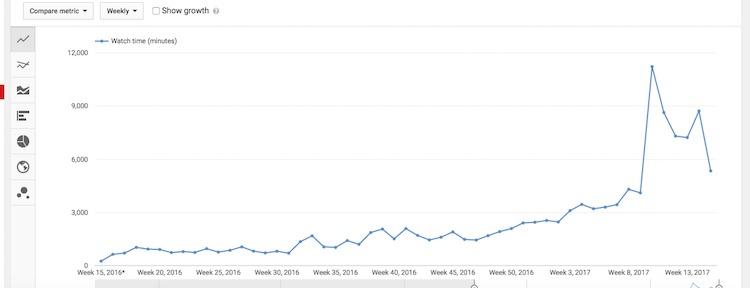
There have been a few big changes we’ve made to Flea’s channel – like sticking to a regular posting schedule, and working on SEO of posts and descriptions. But probably the biggest change has been the amount of time I spend using YouTube Analytics.
For the first couple of years I never used YouTube Analytics. But now I check in a couple of times a week, and we have it to hand when we’re planning what videos to make, how to title them, and when to post them. I also use the Creator app on my phone to check in on the channel daily and moderate comments.
I honestly think if you’re using YouTube without using Analytics, you might as well be filming with a blindfold on. It’s SO simple that I’m kicking myself I didn’t do this stuff sooner.
Today, I’m sharing the seven most important (for us) metrics in YouTube Analytics – and how you can use them to get an insight into how to improve your YouTube channel.
1. Watch Time
This figure tells you how long people have spent watching your videos overall – and how long on average per video. This figure is FAR more important than your subscriber numbers, because it indicates how interesting people find your content, and how long they engage with it. You can view watch time overall, or for specific videos.
In October 2016 (just before the YouTube creator day) Flea Reads’ total watch time was 7,500 minutes from 3,000 views.
In March 2016, it was 35,000 minutes from 15,000 views.
If your subscriber numbers aren’t really growing, it can be disheartening, but tracking your watch time in YouTube Analytics can be really encouraging when you’re making changes.
One thing I really like about YouTube Analytics is you can organise videos into groups – like Group A might be “book reviews” and Group B is “hauls”. Then compare the two to see which sort of video tends to get the best watch time. It’s REALLY useful if you want to make more of the videos your viewers enjoy watching.
For Flea Reads, I can see people tend to spend a lot more time watching book reviews and stationery videos than they do watching other sorts of videos, which helps us when we’re planning.
2. Traffic Source
It’s essential to know how viewers are finding your videos. If you know that your videos aren’t ranking well in search then that’s something you can work on!
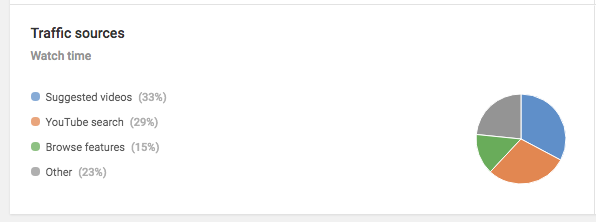
From the analytics for Flea Reads, I can see that around 20% of views come from subscribers, but almost 30% comes from search and 33% from related videos.
This tells me that I could definitely improve how many of Flea Reads’ subscribers are watching regularly – by increasing interaction in videos through shout outs, and encouraging them to turn on notifications so they don’t miss new videos. We’ll also look at perhaps running a poll to ask subscribers which video they want to see next.
3. Search Terms
If we drill down into the “traffic source” report in YouTube Analyics, and find the search terms people used to find Flea Reads, this can also give us insight into what’s working well, and where we can make improvements.
For starters, this chart shows me that the tips I learned at the YouTube creator day about tagging and titling videos to be found has worked BIG time – look at how much the search traffic has increased since November!
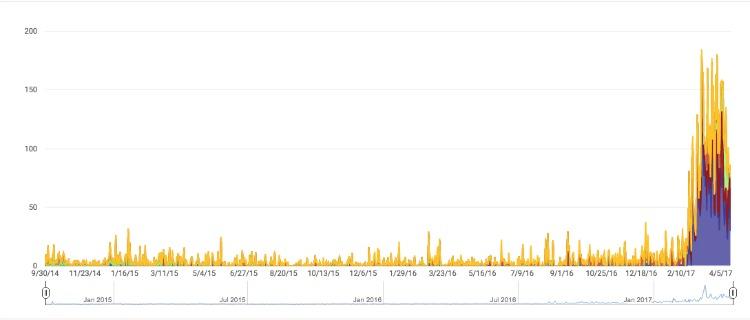
Looking at the stats for March 2017, I can see that:
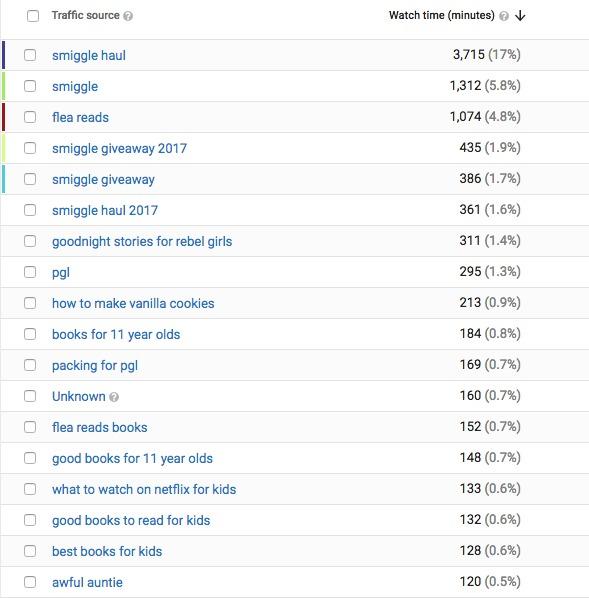
- YouTube Analytics shows that search-related visits the past month came from Smiggle-related terms. People were looking for “hauls” and “giveaways” and sometimes added “2017” indicating they like new and recent Smiggle content, so we’re doing more of that!
- The second biggest source of search traffic was people looking for book reviews for kids. Although some very major book titles were searched directly, it’s more likely people are looking for things like “top books for 10 year olds” “best books for kids” and other general round-up videos. This is key in planning, and we are tending towards doing more group book reviews except for very well-known titles.
4. Audience Retention
One of the things that YouTube looks at when considering how highly to rank a video in its search algorithm is your audience retention. In other words – when someone clicks “play” on your video, how long do they watch? If it’s just a few seconds, this suggests the title was somehow misleading and the video wasn’t what was expected.
The audience retention page in YouTube Analytics will give you this insight. Honestly, it can be a sort of soul-destroying metric as you realise 90% of people stop watching a particular video that you SLAVED over in under 10 seconds, but it’s important knowledge!
Below is the retention for two videos that Flea posted recently.
The first is Flea’s recent video about embarrassing Mums, posted a few days ago.
YouTube Analytics shows me most people watched until the outro of the video. Clearly the video is engaging a decent chunk of people for a decent amount of time. Even so, NOBODY watches all the video. Especially those last few seconds where we post the end screen that we’ve toiled over.
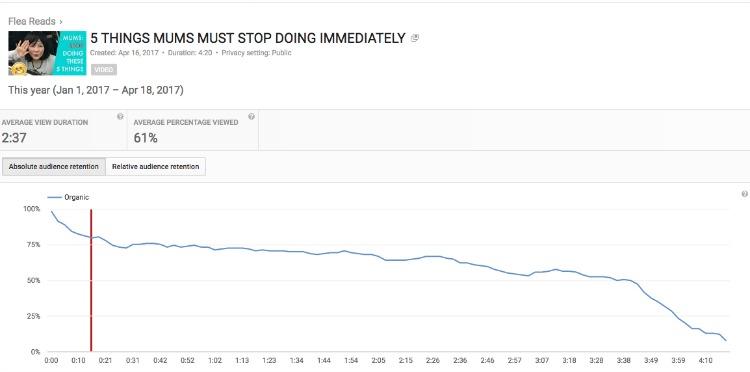
Here’s another video that was – to put it midly – less successful. But on the basis there’s no such thing as failing, only learning, I’m sharing our stats shame.
The video about summer board games to play while travelling CLEARLY wasn’t what people expected. Looking at the search terms that led people to that video, I think they were expecting a video of *video* games – and it’s board games.
So we should have made that clear in the title and the thumbnail. In fact, we’ll probably re-take a cover photo for this video and update the title and tags. Which is another great reason to use analytics by the way. It gives you the insight to be able to give a failing video a new lease of life.
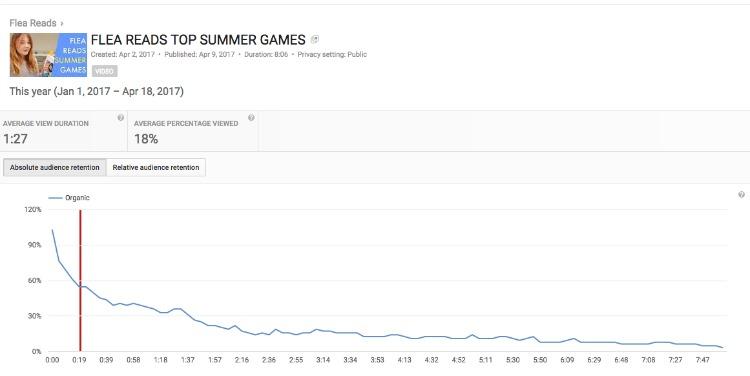
5. Devices
It’s a mobile world, and this applies on YouTube the same as anywhere else. The devices analytics show you exactly how people are viewing your content.
On Flea’s channel, I can see that 77% of viewers watch on a tablet or phone, while just 18% view on a desktop. This means we need to ensure ALL thumbnails work on a mobile screen, and also that we’ve adjusted things like channel headers and artwork to work on these devices.
In terms of thumbnails, we’ve found through A/B testing that a single image with strong, bright colours works best – but ensure the text is limited, big, and bright – so it can be read on a mobile device.
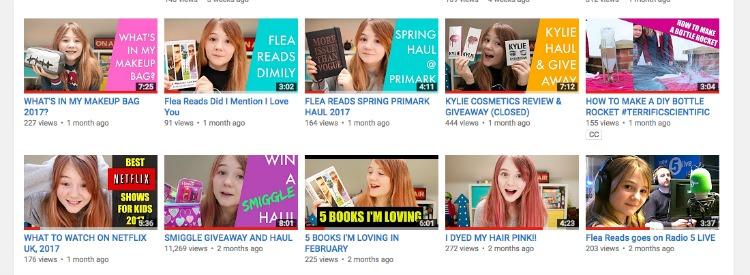
With this in mind, we recently revamped Flea’s video thumbnail templates so they’re more mobile-friendly.
6. Subscribers
It’s easy to fixate on subscriber numbers, but I do believe it’s honestly one of the least important metrics on YouTube. Most of your views on a new channel will come from people who don’t subscribe to you, and it’s entirely possible to get great views and revenue without a large subscriber base.
However, check out the subscriber page in your analytics – it’s a nice way to see how many subscribers you’re gaining/losing, and whether the rate of new subscriber growth is remaining steady, or going up, or down. This chart shows how many new subs a day Flea Reads has had over the past 12 months. See if you can spot when I went on that YouTube workshop!

You can also narrow this down to look at videos by category, or even individual videos to see how a new sort of video is performing – are people subscribing, or deserting the channel when you post those recipes, or shopping hauls?
7. End Screens
The End Screen is a new feature on YouTube and I’m still experimenting to see how it works. But I do recommend not worrying about them TOO much – my analytics shows even the most die-hard fan skips the last few seconds of most videos.
For example, in a month with 30,000+ video views, only 1,300 people got to the end of a video to SEE the end screen. So…. maybe we should be focusing more on getting our retention up, OR using cards and elements earlier in the video to drive views.

YouTube Analytics is a brilliant way to show me which of the available end screen elements are working best for me – I can see that YouTube often suggests the “welcome to Flea Reads” channel trailer video as “best for viewer” but that only 3% of people seeing that will click on it. The click through is much higher for our NYC videos, and a Justin Bieber video. This tells me I shouldn’t be leaving it to YouTube to choose which video to show!
8. Videos in Playlists
The last analytics metric I want to highlight is this one, which shows how often your videos have been added to playlists by OTHER YouTube users – it’s a nice metric that shows how many people want to keep a particular video, and share it with their own subscribers.

Our insights here show that our Netflix video is far and away the most popular video in playlists, being added to over 200 other playlists. Book round-up videos also do consistent well, along with Harry Potter related content.
So… maybe it’s time to make more YouTube videos about Netflix! This is great insight when we’re planning what sort of videos to make in future.
Of course, there’s plenty more to explore in YouTube Analytics but I hope this quick intro might inspire you to dip into your own channel!





This is so helpful Sally. It’s been lovely watching Flea’s channel grow. Thank you so much for sharing. Xx
Wow Sally, this is probably the most helpful post I’ve read about growing YouTube, thank you. I really need to work on this in due course – although I admit it will probably be September now when my littlest goes to pre-school as I just can’t manage to fit it in at the moment. Bookmarking this for then!
Nat.x
This was very interesting. I didn’t know any of this existed as I’m an avid You Tube watcher but not a producer. Just FYI, I went to see Flea Reads just now and started watching the embarrassing mums video. I thought it was great until the gob into the tissue. I had to switch off before that tissue reached her face. If it wasn’t for the gob I might have reached the end. Lots of love from Sqeamish Stomach, Jerusalem.